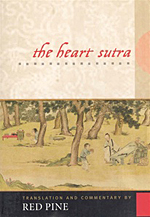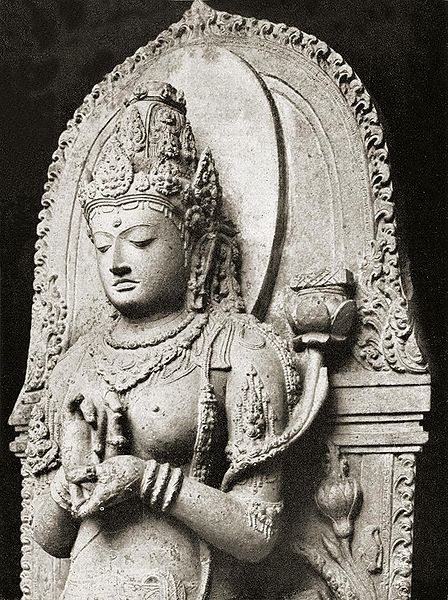
After Clark Strand’s Green Meditation retreat, which dwelt at length on the deep and ancient wisdom of The Heart Sutra, I read the book on the sutra by Red Pine (from 2004.) The sutra itself, one of the most famous texts in all of Buddhism, is of course very short—35 lines or so—an extremely dense distillation of Mahayana wisdom.
The book jacket declares it contains “the essence of the Buddha’s teaching,” which of course any Theravadin would take issue with. But this gets to the point of it all: Red Pine focuses the first part of his commentary on how polemical the text is, set up in explicit opposition to early Buddhist schools such as the Sarvastivadins. Now extinct, this school was very influential in the early days of Buddhism, as in the time of King Ashoka. The name Sarvastivada can be traced to the Sanskrit for “all exists.” They believed that all dharmas (the factors or building blocks of existence, or the elements of the mind itself) exist in the the three times—the past, present and future. The long list of negations in the Heart Sutra (which Edward Conze believed to have been written by a disillusioned Sarvastivadin monk) is explicitly aimed at taking down the beliefs.
Though they are nowadays known for their portion of the Abhidhamma that has survived, the Sarvastivadins also held that each day we are born and die 64,400,099,998 times, according to Red Pine. 64 billion (i.e. 64 thousand million) is quite a large number, but with financial headlines all over the news, we’re getting wearily familiar with hearing about “things” this big (though just what “things” you’d be hard-pressed to define… emptiness.) A billion seconds takes about 31.7 years, according to Wikipedia.
 Prajnaparamita, transcendent wisdom, the perfection of wisdom, lies at the heart of the Heart Sutra. (You can read about Prajnaparamita on Wikipedia, from which the image at right is taken.) It’s also called the womb or mother of Buddhas, since in Prajnaparamita texts Buddhas are born not from nirvana but from the practice of prajnaparamita:
Prajnaparamita, transcendent wisdom, the perfection of wisdom, lies at the heart of the Heart Sutra. (You can read about Prajnaparamita on Wikipedia, from which the image at right is taken.) It’s also called the womb or mother of Buddhas, since in Prajnaparamita texts Buddhas are born not from nirvana but from the practice of prajnaparamita:
For without the Prajnaparamita, the [bodhisattva] vow is simply too overwhelming to attempt, much less fulfill. But once it is seen in the light of Prajnaparamita, this vow is open to all, regardless of their capacity or preferred from of practice. This is because the limiting categories of time and space disappear. Though it takes countless aeons to liberate all beings, the bodhisattva asks, ‘What aeons? What beings? What liberation?’
The text of the sutra (more properly a dharani) is chanted daily at Zen centers around the world, and includes what Red Pine calls the most famous formulation of Mahayana Buddhism: “Form is emptiness, emptiness is form.”
You can find the complete text in many slightly differing versions all over the web. It’s well worth reading (or reciting.) Red Pine’s book is worth a look too. Among other things you’ll get a brief excellent retelling of the life of Shariputra, one of the Buddha’s chief disciples. He is often depicted at the Buddha’s right hand in iconography, and was used as a whipping boy in many later sutras because of his close connection with the early tradition.
Gate, gate, paragate, parasangate, bodhi svaha.
UPDATE: A Heart Sutra “summit” from 2008 with Red Pine and Ken McLeod
Thank you for subscribing to Tricycle! As a nonprofit, we depend on readers like you to keep Buddhist teachings and practices widely available.